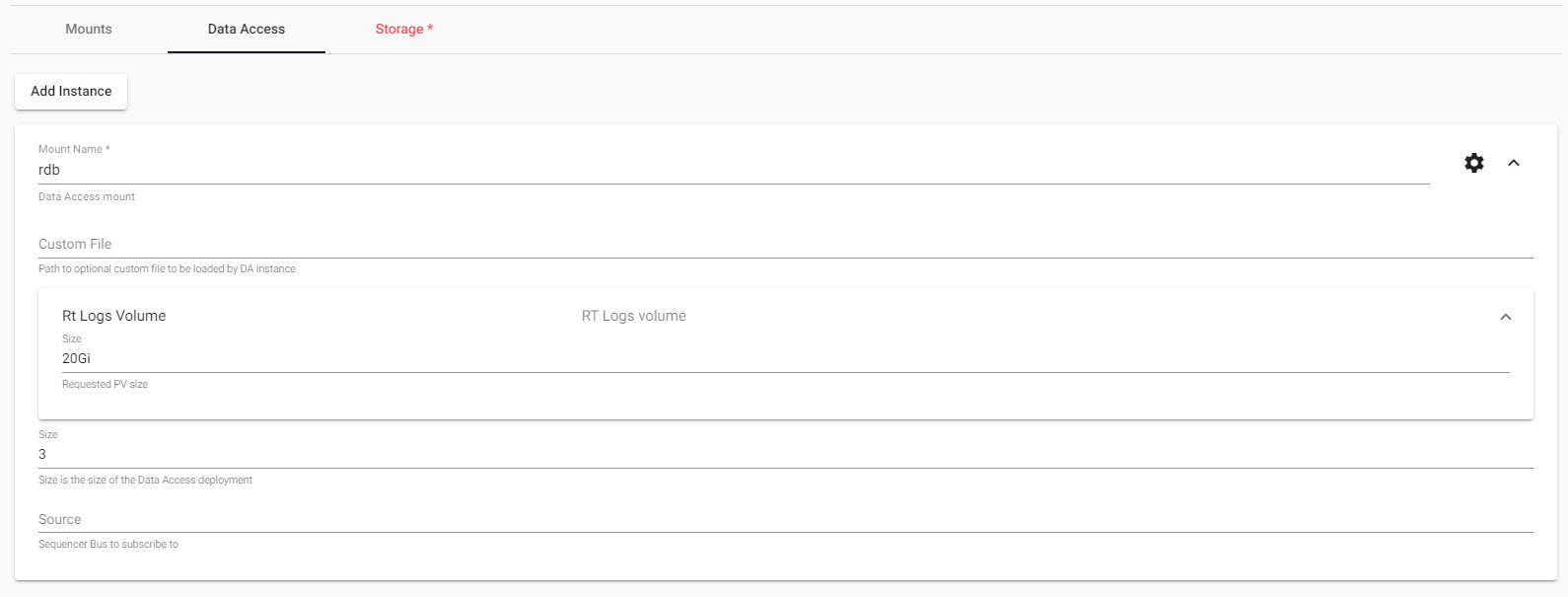Database
Create a database using the UI. A database is used to store the data you will need to ingest. Important is knowing the structure of incoming data with respect to column header names and desired kdb+ datatypes. Free tier comes with an insights-demo database, it just needs to be deployed; insights-demo is listed under the Data menu in the entity tree. New users should first create a database using the wizard.

Set up
-
Select between Time-series or Custom database.
-
Define database name; Submit.
-
Custom databases have a standard or advanced configuration for a Mount; in advanced mode, configure additional details for Mount, Data Access and Storage. Default settings are sufficient for creating a new database.
-
Submit
Time-series
A quick start option for creating a database with a predefined time-series configuration.
- Database Name
- Name of database.
- Advanced
- Toggle for additional database configuration options.

Custom
A standard database with custom Mounts.
- Advanced
- Toggle for additional database configuration options.
- Database Name
- Name of database.

Mount
| item | description |
|---|---|
| Name | Name of mount, e.g. rdb. |
| Type | Select from stream, local, object or purge. |
| Partition | Partition scheme for the mount, e.g. none, ordinal, date, month, year. |
| Dependencies | List of mounts required to be mounted as a dependency of this mount. |
| BaseURI | Uniform Resource Identifier (URI) representing where data can be mounted by other services; set to none. |
| Frequency | A timespan in q notation. How often should this tier roll data over into the next tier, e.g. 00:00:00 or 0D00:00:00. |
| Snap | A time in q notation. At what whole multiples of time should rollovers be scheduled, e.g. 00:00:00 or 0D00:00:00. |
| Retain | A timespan consisting of a number followed by a unit: (Years, Months, Weeks, Days, Hours, Minutes or Seconds), e.g. 2 Years. Rollover occurs for data which has been stored for this length of time. |
Advanced
There are no required configurations for a database in the Advanced menu.
Define Mounts

| item | description |
|---|---|
| Name | Name of mount, e.g. rdb. |
| Type | Select from stream, local, object or purge. |
| Partition | Partition scheme for the mount, e.g. none, ordinal, date, month, year. |
| Dependencies | List of mounts required to be mounted as a dependency of this mount. |
| BaseURI | Uniform Resource Identifier (URI) representing where data can be mounted by other services; set to none. |
| Description | A description of the purpose of the mount. |
| Volume | Requested PV size. |
Add Instances

| item | description |
|---|---|
| Name | Name of data access mount, e.g. rdb. |
| Custom File | Path to custom file loaded by DA instance'; e.g. /full/path/file.q or mount name, e.g. $volumemount/file.q. |
| RT Logs volume | Set requested PV size, e.g. 20Gi. |
| Size | Size is the size of the Data Access Deployment; default to 3 |
| Source | Sequencer Bus to subscribe too. |
Tiers
Add and configure Tier properties

| item | description |
|---|---|
| Mount | The name of the corresponding mount at which data in this tier can be accessed, e.g. rdb. |
| Name | Reference to a particular tier. |
| Description | (Toggle dropdown). Description of tier purpose. |
| Store | (Toggle dropdown). A URI describing where this tier will physically store data. |
Compression
Optional compression policy for data.
| item | description |
|---|---|
| Algorithm | Select algorithm to apply from dropdown list; defaults to none. |
| Block | Define block size for compression; numeric value. |
| Level | Set compression level; numeric value. |
Retain
Policy for how much data should be stored in this tier before it rolled over into the next tier.
| item | description |
|---|---|
| Rows | Rollover occurs for data beyond the number of rows set by this variable. |
| Size | Threshold of tier size before rollover occurs. Number in byte size followed by unit, e.g. 2 TB. |
| Size Pct | Threshold of tier size before rollover occurs, expressed as a percentage of total storage for the corresponding mount; value between 1 and 100. |
| Time | Time threshold for rollover of data stored for this length of time. A timespan consisting of a number followed by a unit, e.g. 2 Years. |
Schedule
Policy for when rollovers should be considered.
| item | description |
|---|---|
| Frequency | A timespan in q notation. How often should this tier roll data over into the next tier. |
| Snap | A time in q notation. At what whole multiples of time should rollovers be scheduled. |
Storage
| item | description |
|---|---|
| Enforce Schema | Enable to enforce table schema when persisting - used for debugging, may incur performance penalty. |
| EOD Peach Level | Level at which EOD peaches to parallelize HDB table processing; select between part or table. |
| Rt Logs Volume Size | RT logs volume requested PV size, e.g. 20 Gi. |
| Size | Size of the Storage Manager deployment. |
| Sort Limit GB | Memory limit when sorting splayed tables or partitions on disk in GB. |
| Source | Either a URI pointed at a static data source of the name of an entry in bus from which to obtain streaming data. |